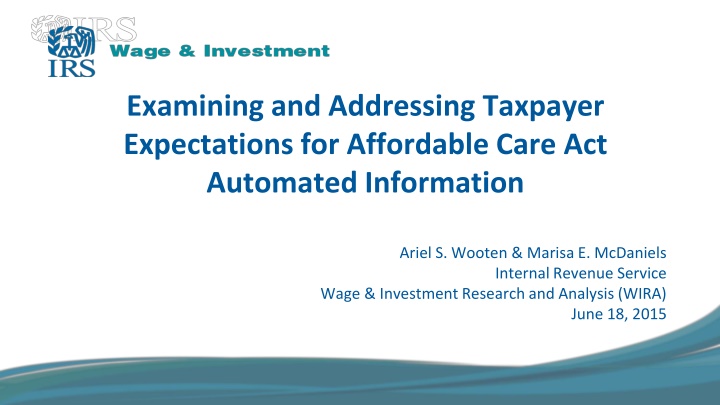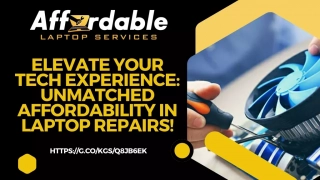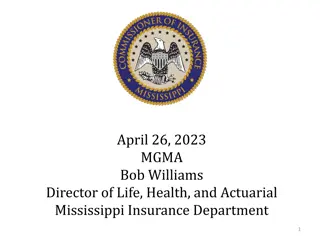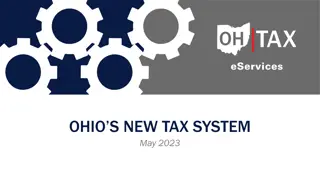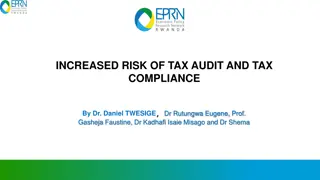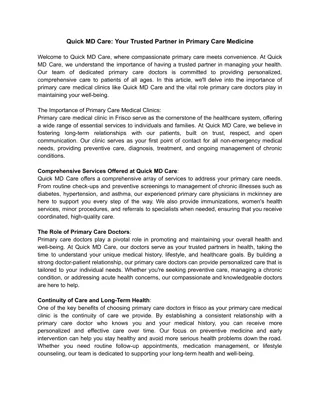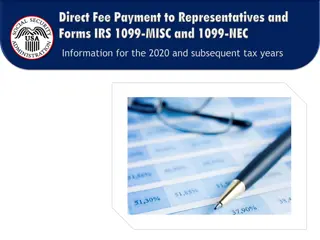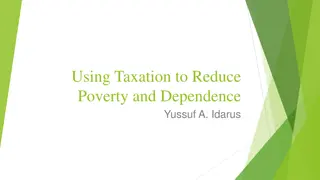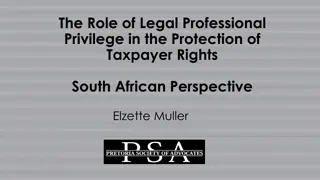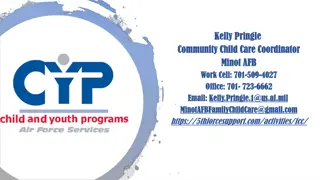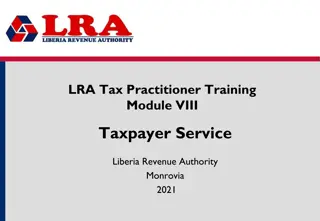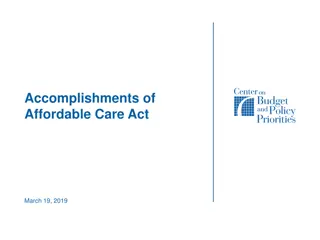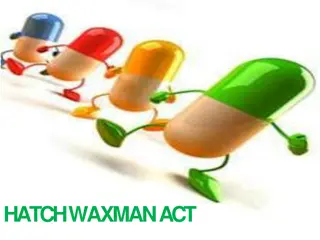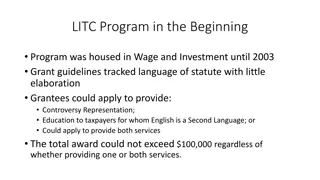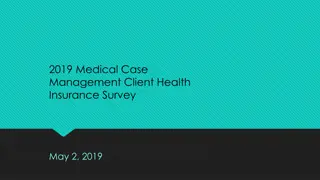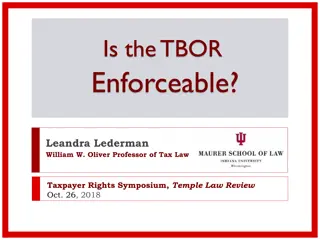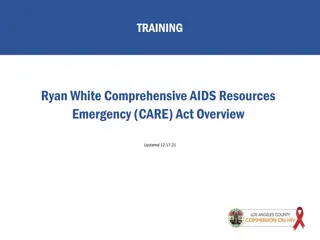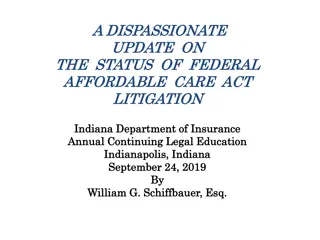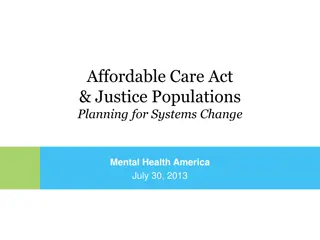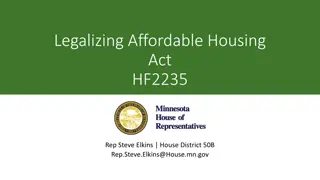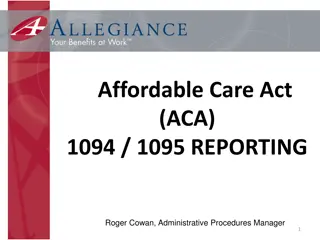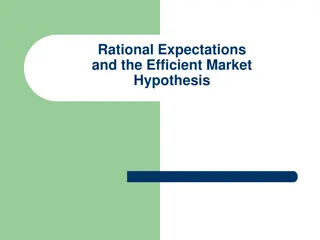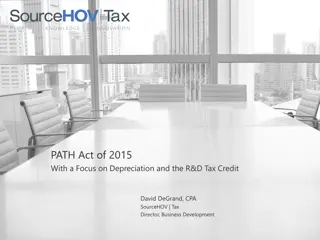Taxpayer Expectations for Affordable Care Act Information
This study conducted by the IRS aimed to explore taxpayer expectations regarding the Affordable Care Act information provided through the automated phone line. By understanding taxpayer perspectives, the IRS can improve service levels, enhance voluntary compliance, and reduce burden for both taxpayers and the IRS. The research involved testing sessions, comprehension evaluations, toll-free ratings, and focus group discussions with eligible participants to gather valuable insights.
Download Presentation

Please find below an Image/Link to download the presentation.
The content on the website is provided AS IS for your information and personal use only. It may not be sold, licensed, or shared on other websites without obtaining consent from the author.If you encounter any issues during the download, it is possible that the publisher has removed the file from their server.
You are allowed to download the files provided on this website for personal or commercial use, subject to the condition that they are used lawfully. All files are the property of their respective owners.
The content on the website is provided AS IS for your information and personal use only. It may not be sold, licensed, or shared on other websites without obtaining consent from the author.
E N D
Presentation Transcript
Examining and Addressing Taxpayer Expectations for Affordable Care Act Automated Information Ariel S. Wooten & Marisa E. McDaniels Internal Revenue Service Wage & Investment Research and Analysis (WIRA) June 18, 2015
Table of Contents Background 3 Study Participants 4 Testing Locations 5 Testing Sessions 6 Comprehension Testing 7 Toll-Free Ratings and Focus Groups 8 Comprehension Testing Findings 9 Toll-Free Ratings Results 12 Focus Group Themes 14 Research in Action 15 Conclusions 16 2 Testing the Affordable Care Act (ACA) Toll-Free Line| W&I Research and Analysis
Background Objective: To explore and capture taxpayer expectations for receiving Affordable Care Act (ACA) information provided through the Internal Revenue Service (IRS) automated phone line. Benefits of the Research: Allow the IRS to pre-emptively plan and allocate resources based on taxpayer experience and expectations rather than relying on lessons learned during implementation. Assist in making informed decisions to improve level of service, facilitate voluntary compliance, and reduce taxpayer and IRS burden by incorporating taxpayers perspective. 3 Testing the Affordable Care Act (ACA) Toll-Free Line| W&I Research and Analysis
Study Participants Eligibility requirements: 18 years of age or older Taxpayers who earned wages in tax year 2013 Filed a tax year 2013 tax return between January 31, 2014 and April 15, 2014. The sampling pool was stratified based on gender, age, filing status, tax return preparation method, and adjusted gross income (AGI). IRS provided a contractor with a list of taxpayers who met the criteria in order to complete study recruitment. 119 taxpayers (80 individual participants and 39 small business participants) were recruited. 4 Testing the Affordable Care Act (ACA) Toll-Free Line| W&I Research and Analysis
Testing Locations Four geographically diverse cities were selected to host testing sessions. A total of 12 testing sessions (three per city) were conducted at IRS facilities in Washington, D.C.; Austin, TX; Denver, CO and Atlanta, GA. 5 Testing the Affordable Care Act (ACA) Toll-Free Line| W&I Research and Analysis
Testing Sessions Each 90 minute session consisted of a three-part testing sequence used to evaluate the Health Care Detail phone line and the Automated ACA Information phone line: Comprehension Testing: Participants were provided a series of fictional scenarios and asked to answer comprehension questions. Toll-Free Ratings Sheet: Participants then completed a questionnaire evaluating their experience using the toll-free automated line. Focus Group: Participants shared their overall user experience and recommendations during a focus group discussion. 6 Testing the Affordable Care Act (ACA) Toll-Free Line| W&I Research and Analysis
Comprehension Testing To facilitate a realistic experience, participants were provided fictional scenarios (based on the automated content) to use while calling into the toll-free line. Participants were asked to answer comprehension questions to determine how well they understood the information. 7 Testing the Affordable Care Act (ACA) Toll-Free Line| W&I Research and Analysis
Toll Free Ratings and Focus Groups As part of the testing session, participants were asked to rate their experience, overall satisfaction, and future willingness to use the ACA toll-free automated phone line using a four-point rating scale. During the focus group portion of the testing session, participants were asked to share feedback on their experience and provide recommendations for improvement. 8 Testing the Affordable Care Act (ACA) Toll-Free Line| W&I Research and Analysis
Comprehension Testing Findings Overall, both individual and small business participants experienced difficulty navigating the toll-free line and often were not able to reach the intended information. Across all scenarios, 80% to 100% of individual participants correctly identified either IRS.gov or Healthcare.gov as sources for additional information compared to 45% to 75% of small business participants. Nearly half (46%) of all responses from small business participants and over three quarters (76%)of all responses from individual participants reveal that participants self-reported being unable to successfully resolve their issue in the allotted time. Approximately 65% of responses from individual participants and 42% of responses from small business participants indicated a desire to speak to an assistor while working through the scenarios. 9 Testing the Affordable Care Act (ACA) Toll-Free Line| W&I Research and Analysis
Comprehension Testing Findings Across all scenarios, individual participants who reported being unable to resolve their issue were overwhelmingly more likely to desire to speak to an assistor when compared to individual participants reporting issue resolution. 10 Testing the Affordable Care Act (ACA) Toll-Free Line| W&I Research and Analysis
Comprehension Testing Findings Despite variation across scenarios, overall, small business participants who reported being unable to resolve their issue were more likely to indicate a desire to speak to an assistor when compared to small business participants who reported issue resolution. 11 Testing the Affordable Care Act (ACA) Toll-Free Line| W&I Research and Analysis
Toll-Free Ratings Results Individual participants reported not being satisfied (57% not at all satisfied) and experienced varying levels of difficulty while completing the tasks (27% very difficult, 33% difficult). Small business participants were more satisfied (56% slightly satisfied) and reported that the tasks were easy to complete (61% easy). Overall, 67% of participants reported being unwilling to use the automated phone service in the future. 12 Testing the Affordable Care Act (ACA) Toll-Free Line| W&I Research and Analysis
Focus Group Themes The qualitative testing session data was collected by WIRA through focus groups to better understand the taxpayer experience using the ACA toll-free line and obtain common themes. Participants do not understand the IRS s role in implementing ACA in comparison to other agencies. I think if they could, it would be better if they separated. If you wanted to find out about healthcare that you wouldn't be working, doing anything, with the IRS at all unless you had a specific question about your taxes, having to do with healthcare. 1 When calling the toll-free line, participants would prefer to resolve their issue within that service channel. If I'm calling the phone number, it's because I want information from the phone number. If I was going to go to the website, I would've started with the website. 2 Participants expectations impact satisfaction. I expected that I could push buttons and get a recorded answer to the question. That didn't happen. Then I thought I'd probably be able to find a person. That didn't happen, and then I thought, Am I doing this right? 3 1Austin, TX Focus Group, 08/20/2014, 11:00AM 2Denver, CO Focus Group, 08/22/2014, 11:00AM 3Austin, TX Focus Group, 08/20/2014, 11:00AM Testing the Affordable Care Act (ACA) Toll-Free Line| W&I Research and Analysis 13
Focus Group Themes The participants have a genuine desire to be compliant, but require more detailed information. You're calling to gain information. Some of what she was telling you, could answer your question. But if it doesn't answer your question, you kind of zone out, trying to get to-- how do I get my question answered? 4 Making other information channels available would be appreciated. I think maybe even better than this approach would be alive chat. You know how you do that, when you've got computer problems, and you can type in something? You usually get a response a lot quicker. 5 Call back, that's a good idea. Automatically call you back when they re ready. 6 Changes to certain logistical elements of the phone tool will create a smoother user experience. I found the computer voice distracting, as opposed to a real recorded person's voice. 7 4Washington, D.C. Focus Group, 08/14/2014, 11:00AM 5Denver, CO Focus Group, 08/22/2014, 2:00PM 6Atlanta, GA Focus Group, 08/29/2014, 9:30AM 7Denver, CO Focus Group, 08/21/2014, 3:00PM Testing the Affordable Care Act (ACA) Toll-Free Line| W&I Research and Analysis 14
Research in Action In November 2014, an IRS cross-functional workgroup participated in a two- day ACA Toll-Free Design Meeting. The purpose of this meeting was to craft proposed ACA-related verbiage changes to the IRS automated phone line. Critical components to this collaborative effort were the consideration of key findings and recommendations from this research study along with the application of subject matter expertise in drafting prompt/message changes. Changes to the content, organization, and delivery of information on the ACA automated line went live on 01-16-2015, helping to shape taxpayer expectations as the IRS geared up for the start of the 2015 Tax Filing Season. The revised scripts set taxpayer expectations upfront related to live assistance helping ease and/or avoid the frustration of taxpayers who can unnecessarily find themselves caught in an endless loop of automated messages while trying to reach a live assistor. Testing the Affordable Care Act (ACA) Toll-Free Line| W&I Research and Analysis 15
Conclusions As outlined in the IRS Strategic Plan, the IRS is dedicated to taking proactive steps to better understand issues from the taxpayer s perspective. This research provides data to assist the IRS in making decisions that will improve level of service, facilitate voluntary compliance, and reduce taxpayer burden by: Shaping and informing expectations to improve overall user satisfaction Ensuring operational decisions are made only after considering the views of affected taxpayers through an informed understanding of the taxpayer experience and perspective. Key findings from this research offer insight for improvements to automated telephone messages and associated content with the goal of striking the optimal balance of providing necessary and relevant information through automation to answer taxpayers questions and/or resolve their issues without having the need to wait in queue to speak with a live assistor. 16 Testing the Affordable Care Act (ACA) Toll-Free Line| W&I Research and Analysis
Project Team Ariel S. Wooten, Project Lead Social Scientist, WIRA Research Group 4 Ariel.Wooten@irs.gov Marisa E. McDaniels Operations Research Analyst, WIRA Research Group 4 Marisa.McDaniels@irs.gov David C. Cico Chief, WIRA Research Group 4 Patti Davis-Smith Social Scientist, WIRA Research Group 4 Maria Wang Operations Research Analyst, WIRA Research Group 4 Robert Thomas Social Scientist, WIRA Research Group 4 Julie Evans Program Analyst, Program Evaluation and Improvement Toni Cross Director, WIRA 17 Testing the Affordable Care Act (ACA) Toll-Free Line| W&I Research and Analysis
